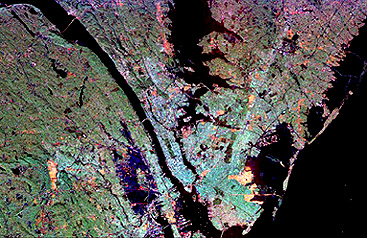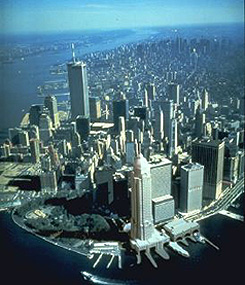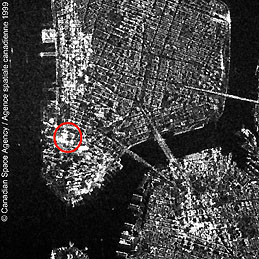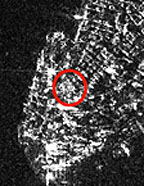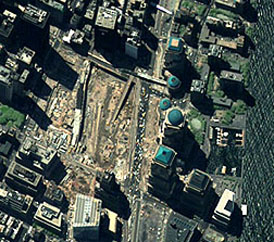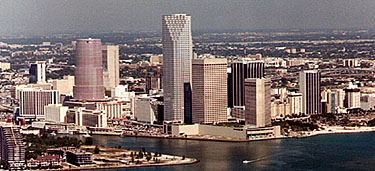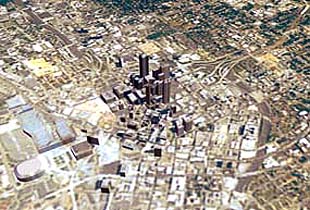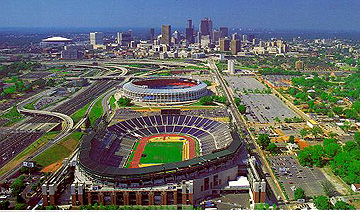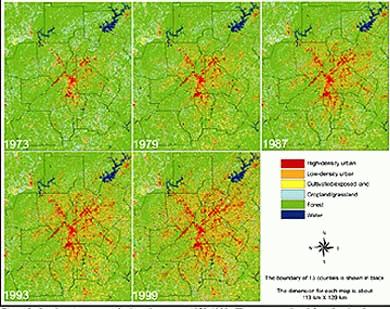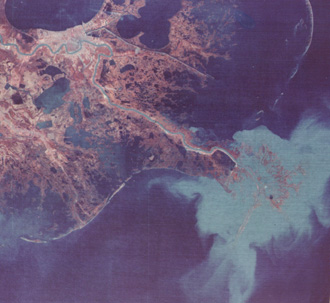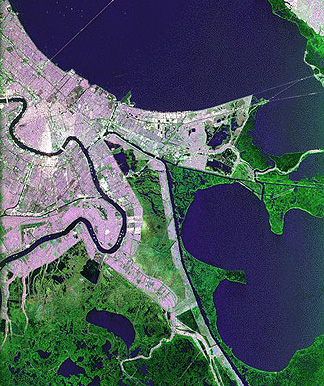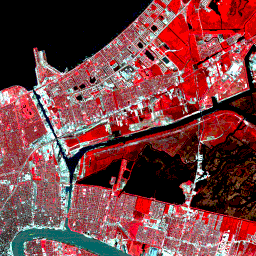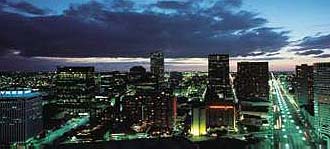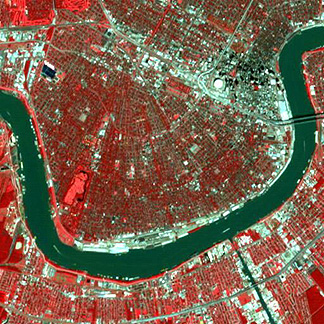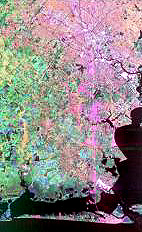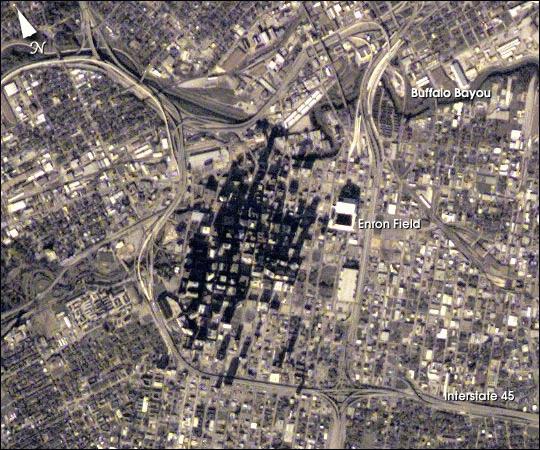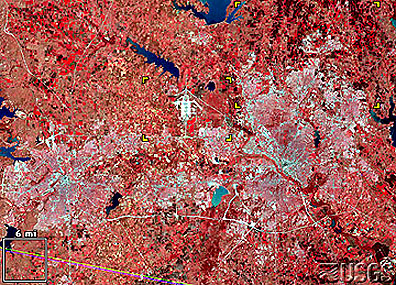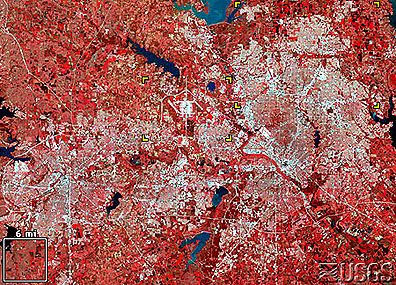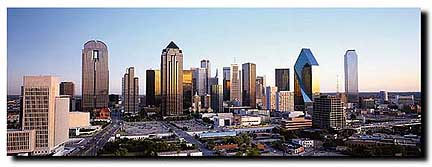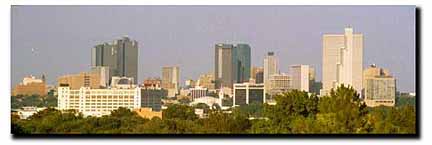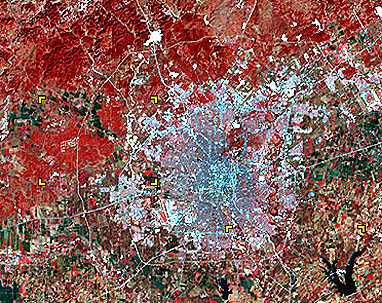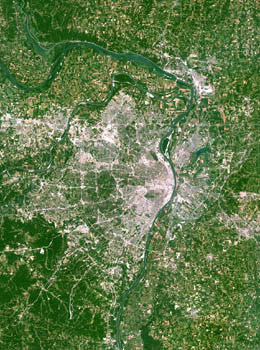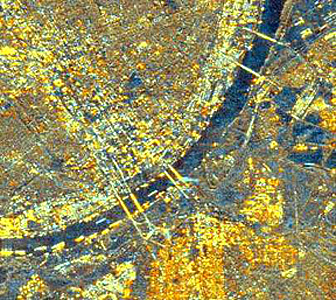New York, Miami, Atlanta, New Orleans, Houston, Dallas-Fort Worth, and St Louis¶
Contents
The focus of attention now shifts to cities in the eastern half of the United States. Images from several satellites are used to highlight the appearance, at different resolutions, of New York, Miami, Atlanta, New Orleans, Dallas-Fort Worth, and St.Louis. The latest version of this page contains IKONOS images of the horrendous damage and loss of life at the World Trade Center Twin Towers resulting from a terrorist attack on Sept. 11, 2001.
New York, Miami, Atlanta, New Orleans, Houston, Dallas-Fort Worth, and St Louis¶
The higher resolution of the Landsat TM facilitates better recognition of many individual buildings, downtown layouts, shopping centers, industrial complexes, and other landmarks in a city. From these images we could draw a street map for most urban areas, if we enlarge the image to fill the screen. We illustrate this with four more examples: the first is New York City and surroundings, then Miami, the largest city on the Florida peninsula followed by the great Mardi Gras city of New Orleans, Louisiana, and finally Atlanta, Georgia. They are similar to Los Angeles and San Diego, being metropolitan areas near sea level.
To start, first look at this SIR-C radar color composite that covers the greater New York-New Jersey-Long Island region, which brings out some of the underlying topography:
Now, let’s look at another Landsat image that focuses on New York City and the New Jersey cities across the Hudson River (you saw this area earlier in the “exam” at the close of Section 1).
westernmost Long Island, and cities on the |
All five boroughs of New York, including Staten Island, are contained in this subscene. Newark, Jersey City, and Paterson are also shown. Look for John F. Kennedy Airport and Central Park in Manhattan. Now, find that Park again in this Landsat-7 subscene in which the 20 meter panchromatic image has been combined with TM Bands 1, 2, and 3. (The orientation has South on the left.)
also shown are part of the Bronx and Brooklyn.|
Manhattan, the lower Bronx, and Brooklyn make up the scene photographed by astronauts onboard the International Space Station (ISS):
Now let’s get down to Earth by zeroing in on Manhattan from the ground, first with a skyline shot and then with an aerial oblique photo looking north from the skyscrapers in Lower Manhattan (A little tidbit: from a distance one notices that there are two clusters of skyscrapers separated by a gap of lower buildings (mini-skyscrapers). Why? Because of the geology underlying Manhattan - the tall skyscrapers are built on two outliers of hard, firm crystalline rock foundations but the land between contains a hundred feet or so of weak sediment unable to sustain the weight of tall buildings.)
Approximately at 9 AM Tuesday on September 11, 2001 a massive terrorist attack on the United States began with the direct crashing of two highjacked commercial U.S. jetliners onto Towers 1 and 2 of the World Trade Center in lower Manhattan. Both buildings, about 110 stories and 1300 feet high, were so severely damaged that they collapsed within an hour. More than three thousand people lost their lives (and others elsewhere at the Pentagon near Washington, D.C. and in a rural area of southwest Pennsylvania added several hundred more fatalities) from airplanes deliberately used as “human-filled” rockets. The two ground photos below were taken from the same vantage point north of the twin Towers; the first shortly after the second plane had collided with the South Tower and the second soon after both towers had collapsed almost to their bases.
Space Imaging Inc. quickly provided two IKONOS images of the New York scene, one taken before the event and the second within a day after the horrific destruction of these, and several adjacent, buildings. Compare these two views, which illustrate the capability of space imagery to provide an overview of a disaster in an urban center:
On Saturday, September 15, after much of the smoke and dust was cleared by a heavy rain, IKONOS captured this 1-meter resolution image (a bit degraded in this rendition) of the World Trade Center devastation and the avenues filled with rescue and recovery vehicles:
The devastation in Lower Manhattan was also monitored by satellite radar. Below is a high resolution SAR mode image taken from Canada’s Radarsat, with the World Trade Center complex circled in red, at a pass (August 1999) well before the Sept. 11 catastrophe:
This next image was also made by Radarsat just two days after the terrorist attacks. But shown is a subset extracted from that image and enlarged to show more detail:
Also, several days later, the AVIRIS hyperspectral sensor, flown on an aircraft (see Section 13 for details on this instrument), was directed over the site. With one of its long wavelength bands as part of a color composite, AVIRIS was able to detect “hot spots” of smoldering flames, as seen in this image:
Nearly a year later, in mid-August 2002, IKONOS imaged ground zero at the time that the destruction site was declared cleared of recovered bodies and debris. Here is a subset from that image.
But, let us next return to more halcyon days before the Terrorist War, and look at southern Florida. We establish a framework for the Miami metropolis by looking at our first large Landsat mosaic (others are treated in Section 7) constructed from several individual TM scenes, each rendered in quasi-natural color.
This mosaic extends from the Florida Keys at the bottom to the Orlando area in the center of state at the top. To the east is Cape Canaveral, site of all manned and many unmanned NASA space launches. Having set up your bearings, look for the following features an atlas: the Tampa-St. Petersburg area around Tampa Bay; Fort Myers; Sanibel Island; Lake Okeechobee; the Everglades; Alligator Alley; Fort Lauderdale; the greater Miami region. The famed Everglades is essentially a wide river of sluggish drainage, flowing over sink depressions through a vast expanse of open water and land covered by sawgrass and hammocks - “tree islands”, seen in the photo below as irregular, often elongated patches of hardwoods. The Everglades, a subtropical environment, is being ecologically threatened as building and drainage to convert to farmlands has seriously disturbed its natural state. Almost half has been destroyed in the 20th Century; state and federal programs are rallying to save and better manage the remainder.
This Landsat subscene affords a closer look at the a large part of the Everglades:
Along the southern coast are mangrove swamps and marshes. An extensive farm region has been cultivated in reclaimed land between Lake Okeechobee and the northern edge of the present Everglades. The widely dispersed lake country in central Florida develops from sinkholes and other internal drainage features in the limestone bedrock.
` <>`__4-6: Find each of the above features in the mosaic, drawing on an atlas as your guide. Where are the Florida Keys? **ANSWER**
Next, we view a false-color Landsat TM subscene that covers the Miami area and much of the Florida Gold Coast, from West Palm Beach to Fort Lauderdale.
The city and its suburbs generally hug the coastline, being prevented from spreading inland by the eastern edge of the Everglades. The elongated red features that seem to follow curvilinear tracks are hammocks, whose distribution follows water flow patterns. The linear red features are sloughs dredged by engineers to better control flow. The offshore bar that makes up Miami Beach is conspicuous. The slanted linear feature passing through Miami is the Miami Canal that parallels Route 27. Reclaimed swamplands to the north are converted to large farm tracts.
Like most large American cities today, Miami’s downtown has an impressive collection of tall buildings:
` <>`__4-7: Along the coast, locate Coral Gables, Key Biscayne, Miami Beach, Hollywood. Is Fort Lauderdale in the scene? **ANSWER**
One of the fastest growing cities in the eastern U.S. in last 30 years is Atlanta, Georgia. Here is a Landsat-5 subscene taken on June 8, 1999.
This next image was made by an airborne multispectral scanner; rather surprising is the low number of high rise buildings in the downtown area. Most growth has led to a great expansion of suburban areas.
Obviously, even more information about an urban center will result from higher resolution imagery. This next subscene shows part of central Atlanta, Georgia, as imaged by the Kosmo’s 2-meter KVR-1000 film camera, which flew on the Russian MIR Space Station. This space photo has many of the qualities and details of aerial photos. Features of interest include the Atlanta-Fulton Co. Stadium, until 1997, home of the Braves baseball team, and the convoluted intersection of Interstates 20 (east-west) and 75-85 (north-south).
MIR orbiting manned station; resolution approaches 2 meters.|
Now, this sports complex has expanded, as shown in this recent photo with the downtown in the background:
You should be able to match this photo to the Kosmos scene above.
Using Landsat data over the last 26 years, these subimages (reworked as classifications) really reveal the magnitude of urban growth in the Atlanta region:
Turning to New Orleans, let’s set the city into context with its surroundings by looking at two images. The image below is a full Landsat MSS image, in which the city appears in the upper left between Lake Ponchartrain and meanders of the Mississippi River. This January 1973 scene is dominated by the “birds-foot” distributaries and bayous of the Mississippi Delta. They are set off by the subdued false-color reds of the swampy vegetation in moderate winter dormancy, and by the pronounced chalky blue of sediments from the river, as it empties at the currently-active distributary.
Zeroing in on the city itself, this Landsat-7 natural color subscene shows the entire city - mostly on the east side of the Mississippi and parts of Lake Ponchartrain (you can just make out the causeway bridge that was built from New Orleans to the south edge of the lake).
Now look at the TM false-color composite that is a subset from a Landsat 5 scene obtained on March 24, 1985. Below it is a night view of central New Orleans - this city really comes to life after dark, when the humid heat cools and the activities that make this a Fun City commence.
Remember that the resolution is 30 m (98 ft). The subscene covers a part of the eastern half of the Crescent City, starting with just a bit of the world-famous French Quarter, at the bottom-left corner of the image (Bourbon Street near the Cathedral of St. Louis just enters there). The French Quarter extends from the docks along the Mississippi River, which has powder blue color, resulting from its high silt content that imparts increased reflectance in TM Band 2. Many of the city streets form true square blocks. Some of the larger buildings in this scene are resolvable at the TM’s 30 m. resolution. The reds in the city proper are signs of the luxuriant vegetation that is profuse throughout this lovely city. The large body of water, at the top, is the south shore of Lake Pontchartrain, a 57 km (35 mi) wide (1619 sq. km; 625 sq. mi) inland, brackish (mildly salty) lake that connects by an eastward channel to Lake Borgne, which is a saltwater body joined by the Mississippi Sound to the Gulf of Mexico.
Running through the city is part of the Gulf Intracoastal Waterway, a continuous 1725 km (1072 mi) long water route from Carrabelle, Florida to Brownsville, Texas. It also connects with the Mississippi River to provide a protected canal-like passageway for pleasure boats and freight barges. Where it doesn’t use the open Gulf of Mexico, the waterway is cut inland from the shore to an average depth of 3.7 m (12 ft) and width of 38 m (125 ft). This waterway also merges in the scene with the Inner Harbor Navigation Canal that joins Lake Pontchartrain to the Mississippi River. Note the wharfs along it. Interstate 10 runs eastward here passing through the Gentilly section of New Orleans. Highway 46 follows the river through the suburb of Chalmette. To its north is a large swampy area, or bayou, in St. Bernard Parish. Much of this area is heavily vegetated, but open water (blackish) takes up most of the interior. The New Orleans Lakefront Airport juts into Lake Pontchartrain. Green areas to its southwest are Pontchartrain Park and the University of New Orleans campus.
Now look at another view of central New Orleans, lying mainly to the southwest of the Landsat subscene. This subscene, about 9 km (6 mi) on a side, shows the city at 10 meters resolution, as imaged by the multispectral scanner on JERS-1, a Japanese satellite launched in 1992. Note the radial pattern of the streets that act like spokes against 000the crescent bend of the Mississippi River. The large white round feature is the Superdome, site of several football Superbowls. Tall buildings downtown are just to its right. The dark patch nearby is astride the Vieux Carre or French Quarter.
` <>`__4-8: Locate the SIR-C, Landsat 5, and JERS-1 images in the Landsat MSS subscene. **ANSWER**
The next big city west of New Orleans, and one of the country’s largest, is Houston, where the writer (NMS) spent three years at the University of Houston. To set in in context, look first at this SIR-C X-Band radar image that extends from central Houston to the Gulf Coast at Galveston Island.
The photo below was taken by an astronaut aboard the International Space Station. The camera used is capable of much better resolution than has been acquired in most previous manned missions from space (see Section 12). This view of downtown Houston shows a part of the freeway system built through and around this city. Both Houston and Dallas-Fort Worth (below) have more major urban area road networks than most other American cities, owing to the foresight of transportation planners in recognizing that future growth requires such roadways even at the expense of replacing (removing) homes, etc. to provide the necessary right-of-ways.
One of the prime uses of space imagery is that aspect of change detection which examines an urban scene after intervals of years or even decades. This is an invaluable aid to regional planners and even to the Bureau of the Census, which has learned how to use these observations in estimating population changes (helpful to the U.S. Congress in re-allocating federal funds). The next two images are of the Dallas-Fort Worth, TX area (see also page 4-5), in 1974 and 1989.
Both of these cities are now major urban centers - a conclusion one would draw from these views of their downtown skylines:
SKYLINE OF DOWNTOWN DALLAS
SKYLINE OF DOWNTOWN FORT WORTH
We will leave it as an exercise for you to evaluate the changes in the 15 years since the 1974 subscene. Are there any new lakes (reservoirs)?
Throughout the Tutorial, but mostly in this Section, we have a number of scenes of Texas. We have, or shall, cover(ed) all Texas’ major cities except San Antonio. To avoid possible negativity from its citizens, we show this Landsat image of the city built around the Alamo. Here:
The writer (NMS) would be amiss (i.e., subject to bad vibes from his relatives and friends there) if he did not feature his home town in this Section. So, below is a Landsat 4 subscene showing St. Louis - the pride of eastern Missouri - the town where, just to its north, the Missouri and Mississippi Rivers meet.
This is a photo of the St.Louis downtown area, including the stadium that Mark McGwire has made famous:
And, for more detail, look at this SIR-C radar (from the Shuttle) composite (see Section 8) of the central city, with East St. Louis on the Illinois side (bottom).
Makes one homesick!
